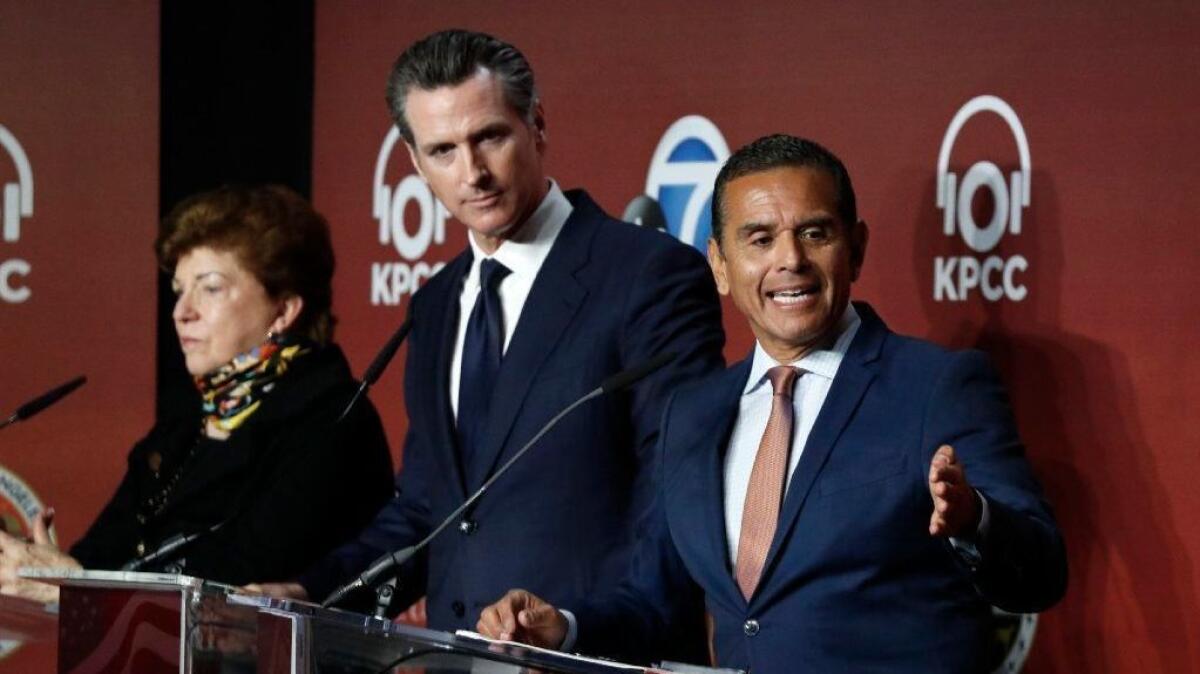Fueled by unlimited donations, independent groups play their biggest role yet in a California primary for governor

- Share via
An unprecedented amount of money from wealthy donors, unions and corporations is flowing into the California governor’s race, giving independent groups — unrestricted by contribution limits — a greater say in picking the state’s chief executive than ever before.
The groups have already spent more than $26 million through Thursday, the most ever spent by noncandidate committees in a gubernatorial primary, according to a Times analysis of campaign finance reports.
“California elections have always been expensive, and the future is even more expensive,” said Jack Pitney, a political science professor at Claremont McKenna College and a former state Republican leader. “The stakes are very real.”
To be sure, California has seen high-spending elections before. GOP nominee Meg Whitman shattered records when she spent $178.5 million on an unsuccessful gubernatorial bid in 2010, including $144 million of her own money. Ballot measures routinely see tens of millions of dollars in spending.
But spending by outside groups — which legally cannot coordinate with a candidate but can accept unlimited donations — has been steadily climbing in recent years.
The campaigns, some of which have been operating for years, have spent more than the outside groups — $40.8 million as of Thursday. But in the run-up to primary day, the independent groups are far outspending the campaigns — $20 million to $14 million between May 1 and Thursday, according to financial disclosure documents filed with the state.
A voter-approved 2000 ballot measure limits how much donors can contribute to candidates. For the current election, it’s $29,200 for gubernatorial candidates in the primary. But donors face no limits in how much they can contribute to outside groups, which are formally called independent expenditure committees.
Former Los Angeles Mayor Antonio Villaraigosa has been the biggest beneficiary of outside spending in this race, with charter school backers spending nearly $16 million on efforts to boost his campaign.
The vast majority of that spending has been devoted to airing television ads to promote Villaraigosa. But some of that money has been spent to influence the competition between the two top GOP candidates in the race, an effort to increase Villaraigosa’s chances of coming in second in the June 5 primary and to advance him to the general election against Democratic front-runner Gavin Newsom.
Many political observers say Villaraigosa, who was stagnating in the polls earlier this year, would not have a chance to finish in the top two without the outside groups’ largesse.
“He’s already in a hole and the best he can hope for is the [independent expenditure] money will enable him to edge into the No. 2 spot, and even that is no sure thing,” Pitney said. “Without the I.E. money, he’d be looking to go back to Herbalife,” the multilevel marketing nutrition supplements company Villaraigosa worked for after leaving the mayor’s office.
Other candidates have also benefited from independent expenditures, notably Newsom. More than $6 million has been spent to support his bid, mostly by unions.
Donations to such groups have steadily increased since the passage of the 2000 ballot measure establishing limits on donations to candidates, according to reports by the Fair Political Practices Commission, the state’s campaign finance watchdog agency.
Ann Ravel, former chair of the FPPC and the Federal Elections Commission, said the greatest increase occurred after the U.S. Supreme Court’s 2010 Citizens United decision. The ruling held that limits on independent political spending by corporations, unions and other entities violated 1st Amendment free speech protections.
Even though such donations were already legal in California, “people just became more aware of it because of the notoriety of Citizens United,” Ravel said. Independent expenditure committees “became a much more convenient way for people to funnel money to races,” she said.
Political observers say the uptick in spending by independent expenditure committees increases the influence of the wealthy.
“It’s not as if the candidates don’t know who gives money to their super PACs,” said Dan Schnur, a veteran political analyst who teaches at USC. “If they return a phone call from a $5,000 donor to their campaign very quickly, they’re going to return a phone call from a $500,000 donor to their super PAC a hundred times faster.”
And many of the donors to the outside groups in the governor’s race are donating in far greater amounts. Villaraigosa’s charter school backers include Netflix co-founder Reed Hastings, who has contributed $7 million; former New York City Mayor Michael Bloomberg and philanthropist Eli Broad, who have contributed $2.5 million each; and major GOP benefactor Bill Oberndorf, who has given $2 million.
Shortly after the charter school proponents backed Villaraigosa, the California Teachers Assn., a powerful force in state politics, steered more than $1 million to Education Organizations for Gavin Newsom for Governor 2018. Other public sector unions, chief among them the Service Employees International Union, gave more than $3 million to Citizens Supporting Gavin Newsom for Governor 2018. That group also received nearly $1 million from health insurance provider Blue Shield of California.
All will have business or interests in front of the next governor.
Ravel said the increase of donations to outside groups has also led to more negative campaigning.
“The difference between I.E.s and a candidate’s own advertising is that the promulgators of I.E. advertising can be a lot more nasty than candidates can — and they tend to be,” she said. “[Candidates] are often not willing to stoop quite as low as independent expenditure committees that are willing to say things that are patently false or really divisive or really nasty.”
Some of the most eyebrow-raising attacks have come from outside groups.
An anti-Newsom digital campaign launched by the Asian American Small Business PAC focused on an inappropriate relationship Newsom had while in office.
Another outside group spent about $2 million to attack state Treasurer John Chiang, the most money devoted to opposing a single candidate by an independent expenditure committee, according to filings with the California secretary of state.
Health Care Providers for Fiscal Accountability Opposed to John Chiang, which received funding from Blue Shield, spent much of its money on mailers that don’t mention healthcare, but instead allege Chiang made “billion-dollar blunders” as treasurer. Those ads drew a rebuke from the state Asian Pacific Islander Legislative Caucus, which called the attacks “unfounded and unwarranted” in a letter to the group’s backers.
The pro-Villaraigosa charter school group has sent mailers to GOP voters calling Republican John Cox a “Democratic activist” and using the logo of Hillary Clinton’s 2016 presidential campaign as the “h” in his first name. It also launched a television ad on Fox News aligning Cox with House Minority Leader Nancy Pelosi, and promoting his GOP rival Travis Allen as the true conservative in the race.
That group, Families and Teachers for Antonio Villaraigosa for Governor, has also aired ads and sent mailers featuring former President Obama praising Villaraigosa, though Obama has not weighed in on the race.
The Cox and Villaraigosa campaigns have filed complaints with state regulators alleging outside committees are failing to properly disclose their intents. The FPPC is unlikely to rule on these complaints before the primary.
Independent groups have a mixed record of success.
In the 2010 gubernatorial election, unions spent tens of millions of dollars to support then-Atty. Gen. Jerry Brown during the summer, an effort that was viewed as crucial to stalling Whitman’s campaign. He ultimately won the race by 13 points.
It’s uncertain whether outside groups will have as much of an influence on the 2018 election, though spending by such groups is expected to grow exponentially if Villaraigosa makes the runoff.
“If he’s No. 2, both sides will be very well funded, a lot of it on the I.E. side, particularly for Villaraigosa,” said GOP strategist Rob Stutzman, who is unaligned in the race. “I think so much so that he would be the favorite if he makes the runoff, that’s the irony of his current position.”
Times staff writer Maloy Moore contributed to this report.
Explore the money pouring into the governor’s race with The Times’ tracker »
Follow California politics by signing up for our email newsletter »
Coverage of California politics »
Twitter: @LATSeema
Twitter: @ryanvmenezes
More to Read
Get the L.A. Times Politics newsletter
Deeply reported insights into legislation, politics and policy from Sacramento, Washington and beyond. In your inbox three times per week.
You may occasionally receive promotional content from the Los Angeles Times.












